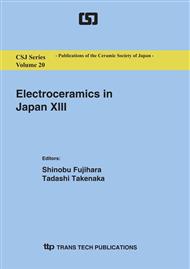p.113
p.117
p.123
p.127
p.131
p.135
p.140
p.144
p.148
Dielectric Properties of Highly (001)-Plane Oriented SrBi4Ti4O15 Thin Films
Abstract:
Thin films of a bismuth layer-structured dielectric oxides (BLSD), SrBi4Ti4O15, with preferential crystal orientation were prepared by means of chemical solution deposition (CSD) technique on (111)Pt/(100)Si substrate with bottom nucleation layers of conductive perovskite oxides, LaNiO3 and SrRuO3. CSD technique was utilized for the film preparation of SrBi4Ti4O15. These films possessed highly crystal orientation of (00l) BLSD planes parallel to the substrate surface. The leakage current densities of the SrBi4Ti4O15 films on (100)SrRuO3//(100)LaNiO3/(111)Pt/Ti/(100)Si and on (100)LaNiO3/(111)Pt/Ti/(100)Si were approximately 10-6 and 10-7 A/cm2 respectively. The dielectric constants of these films in a frequency range of 102 - 106 Hz were from 310 to 350 and 250 to 260 respectively. The value of capacitance change of these films in the range from 20 to 300 oC was about +8 and +5% respectively.
Info:
Periodical:
Pages:
131-134
Citation:
Online since:
July 2010
Authors:
Keywords:
Price:
Сopyright:
© 2010 Trans Tech Publications Ltd. All Rights Reserved
Share:
Citation:


